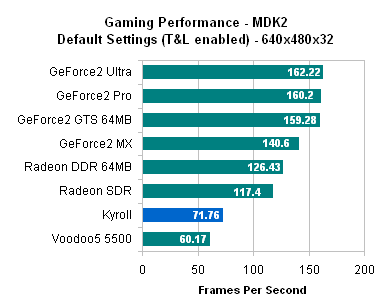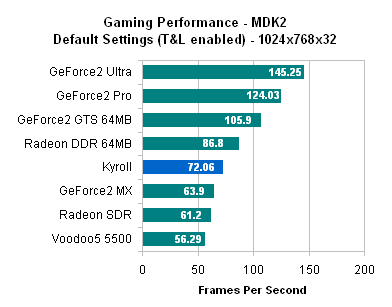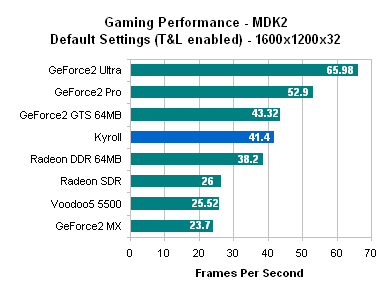MDK2 Performance

It is here, in MDK2 at 640x480x32, that the Kyro II is punished for its lack of T&L. One can clearly see that cards with T&L, all but the Kyro II and the Voodoo5 5500 in this group, perform much better on the whole at this low resolution. Unfortunately, we will most likely have to wait until the next generation PowerVR chip is released before we see this number jump, as it cannot be fixed via a simple driver update.

As the resolution moves up, the Kyro II is not penalized as much for the lack of T&L as fill rate becomes more of a limiting factor. Here the Kyro II steadily beats the GeForce2 MX once again, but this time falls short of the GeForce2 Pro that it once had its sights on. The Kyro II is beaten by the GeForce2 Pro in this case by 72%, whereas in Quake III Arena it only fell 11% short of the GeForce2 Pro's speed. Once again, we will have to wait for a T&L capable PowerVR chip before we see its MDK2 performance increase significantly.

MDK2 at 1600x1200x32 tells pretty much the same story as at 1024x768x32: the Kyro II is held by back its lack of T&L. Not to say that performance in this case is not impressive given its price - the Kyro II still beats out the GeForce2 MX, this time by a huge 74%. There is no question that the extra $30 or so that the Kyro II costs is worth it by far.










4 Comments
View All Comments
MonkeyPaw - Monday, February 24, 2014 - link
Thanks for the stroll down memory lane (by keeping the article up). I had one of these cards back in 2002, and it was one I looked back upon fondly. I can't remember most of the GPUs I owned from yesteryear, save the Voodoo 3 and the crappy S3 Verge. That's fairly elite company, at least in my brain, anyway. :)xrror - Monday, March 2, 2015 - link
Yea, it's sad that there wasn't any further development of the Kyro series in the PC market. If I remember right (probably needs fact checked) Imagination's development resources got sucked into the Sega Dreamcast after this point. Even that wouldn't have been so bad if Sega hadn't just given up on the Dreamcast so early on due to a "poor showing in Japan" (nevermind everyone loved it in the US but we didn't count apparently, also see Genesis/MegaDrive).I think Imagination or at least their tech lives on in the embedded/mobile space now, but meh - really wanted to see what they could have done with their tech without being shackled to a power budget in 2002-2005 era PC's.
Alexvrb - Wednesday, October 14, 2020 - link
You're wrong. The Dreamcast was designed years earlier using PowerVR Series 2. The later "Kyro series" was based on Series 3. The DC design win netted them some much needed cash which they used to fuel their Series 3 releases. What killed imgtech was their inability to play well with others (board partners) and issues staying on schedule for releases. If they had managed to get the 4800 out the door sooner, and released the larger Kyro III with DDR it would have bought them some time. Especially if they had paired it with a hardware T&L block like Elan.thegreatjombi - Wednesday, August 12, 2015 - link
Its very interesting to think that Imagination Technologies could have been another foot note in history (3dfx, bitboys Oy! Rendition..) but going mobile and refining their technology has allowed them to basically become more popular than ATI(AMD) or Nvidia. There are probably more devices in peoples houses running a powervr variant than have an AMD or Nvidia GPU.I do wish someone would stick their chip on a discrete card again, they apparently support full Directx and OpenGL! could be an interesting low profile, low end, low power, fanless card for HTPCs.